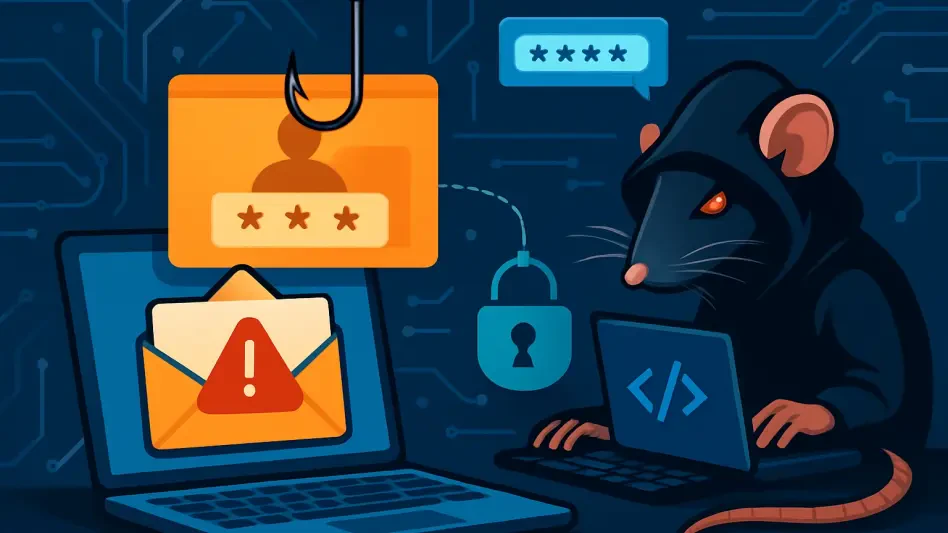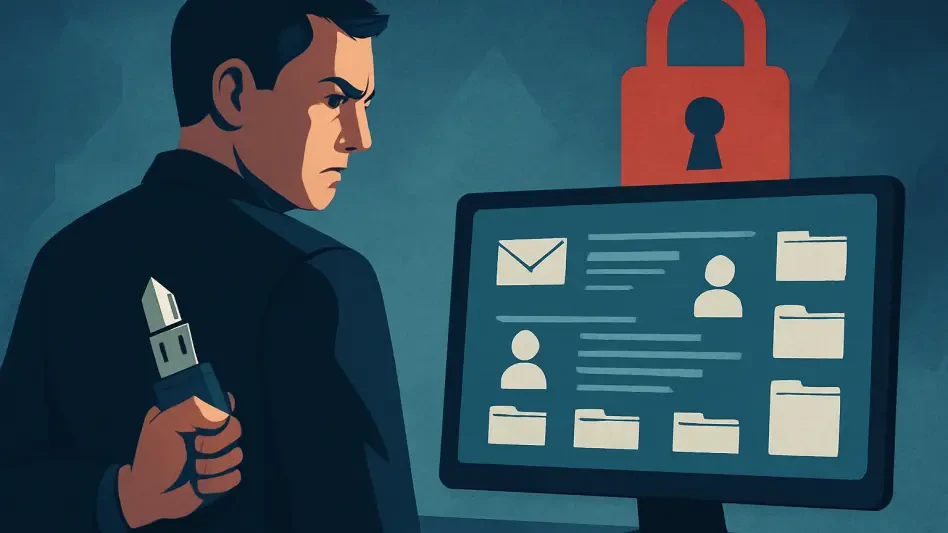In a disturbing turn of events for cybersecurity professionals, a rapidly escalating phishing campaign targeting Windows users across the globe has emerged as a critical threat, according to recent findings by researchers at Fortinet Labs, highlighting the urgent need for robust defenses. Far beyond the typical scams designed to harvest login credentials, this operation takes a darker path by deploying remote access trojans (RATs) that allow attackers to maintain prolonged control over compromised systems. Spanning industries such as manufacturing, healthcare, technology, construction, and retail, the campaign’s reach is alarmingly vast. Detection rates have surged dramatically, more than doubling in a mere two-week span, signaling an urgent need for heightened vigilance. This aggressive expansion, fueled by readily available phishing kits on underground forums, equips even less-experienced cybercriminals with the tools to execute intricate attacks. As organizations scramble to protect their networks, the scale and sophistication of this threat underscore a pressing challenge in the ever-evolving landscape of cybercrime.
Understanding the Threat Landscape
Global Reach and Rapid Proliferation
A defining feature of this phishing campaign is its staggering speed of spread, which has caught the attention of cybersecurity experts worldwide. Within just two weeks of initial detection, the number of identified cases more than doubled, illustrating an unprecedented growth rate that points to a truly global operation. This rapid proliferation is largely driven by the accessibility of turnkey phishing kits and pre-built tools on underground hacker forums. Such resources lower the barrier to entry, enabling attackers with minimal technical expertise to launch highly effective campaigns. The implications are profound, as this democratization of cybercrime tools means that threats can emerge from virtually anywhere, at any time. Organizations across diverse sectors are now finding themselves in the crosshairs, with no region or industry seemingly safe from the campaign’s expansive reach. This alarming trend highlights the critical need for international collaboration and real-time threat intelligence to keep pace with such fast-moving dangers.
Equally concerning is the sheer volume of potential victims exposed to this threat due to its global nature. The campaign’s ability to target multiple industries simultaneously—ranging from healthcare to retail—demonstrates a calculated approach to maximize impact. Attackers exploit the interconnectedness of modern business environments, where a single breach in one sector can ripple through supply chains and partnerships. The use of underground tools also means that the campaign can be easily replicated or adapted by other malicious actors, further amplifying its spread. Cybersecurity teams are now tasked with not only addressing current infections but also anticipating future iterations of similar attacks. The rapid detection surge serves as a stark reminder that traditional response timelines are insufficient against such agile threats. Proactive measures, including continuous monitoring and rapid information sharing across industries, are essential to curb the campaign’s momentum before more damage is inflicted.
Sophisticated Attack Mechanisms
The intricacy of this phishing operation sets it apart from more conventional scams, revealing a multi-layered strategy designed to deceive and infiltrate. It begins with carefully crafted emails that leverage social engineering tactics, often posing as urgent purchase orders or missed voicemail notifications to create a sense of immediacy. These lures direct unsuspecting users to phishing pages that are meticulously personalized, often incorporating the victim’s email domain and company branding to build trust. Once engaged, victims are prompted to download malicious JavaScript files, which serve as droppers for UpCrypter malware. This malware, in turn, facilitates the installation of RATs such as PureHVNC and DCRat, granting attackers deep access to compromised systems. The level of customization in these phishing pages underscores the attackers’ focus on exploiting human psychology, making it harder for even cautious individuals to spot the deception at first glance.
Delving deeper into the attack chain, the role of these malicious scripts reveals a chilling efficiency in execution. After the initial download, the JavaScript files act as a gateway, silently deploying UpCrypter to evade early detection by security software. This malware then orchestrates the delivery of RATs, which are engineered for persistence, allowing attackers to maintain a foothold in the victim’s network over extended periods. The choice of RATs like Babylon RAT alongside others indicates a strategic intent to diversify payloads, potentially increasing the likelihood of bypassing specific defenses. This multi-stage process not only maximizes the chances of successful infiltration but also complicates efforts to trace and neutralize the threat. For organizations, understanding this sequence is vital, as it exposes vulnerabilities in both user behavior and system protections that attackers exploit with alarming precision. The sophistication of these mechanisms demands a reevaluation of current security protocols to address such nuanced threats.
Evasion Tactics and Persistent Impact
Advanced Stealth Techniques
One of the most troubling aspects of this phishing campaign is its use of cutting-edge evasion tactics that challenge even the most robust security systems. The malware employs heavily obfuscated code, laced with irrelevant or junk data, to mask its true intent from antivirus programs and other defensive tools. Beyond this, it actively scans for forensic tools or virtual environments—such as those used in sandbox analysis like any.run or Wireshark—and restarts its processes if such tools are detected. This environmental awareness demonstrates a deliberate effort to thwart investigation and analysis. By executing later stages of the attack directly in memory rather than writing payloads to disk, the malware further reduces its visibility to traditional detection methods. These stealthy maneuvers create significant hurdles for IT teams striving to identify and mitigate the threat before it causes irreparable harm.
Further complicating the defense landscape, these evasion techniques are continuously refined to counter emerging security solutions. The use of memory-based execution, for instance, minimizes the digital footprint left on compromised systems, making it difficult for endpoint detection tools to flag malicious activity. Additionally, the malware’s ability to detect debugging environments suggests a level of sophistication typically seen in state-sponsored attacks, now accessible to a broader range of cybercriminals through underground markets. This adaptability poses a unique challenge, as security teams must anticipate not just current tactics but also potential evolutions of the threat. The reliance on obfuscation also means that signature-based detection methods are largely ineffective, pushing the industry toward more dynamic, behavior-based monitoring systems. As these techniques become more widespread, they signal a shift in how organizations must approach cybersecurity, prioritizing agility and innovation in their defensive strategies.
Long-Term Risks to Organizations
The immediate fallout from this phishing campaign is severe, with credential theft providing attackers a gateway to sensitive information and systems. However, the deployment of RATs introduces a far graver, long-term risk by enabling persistent access to compromised networks. Once embedded, these trojans allow attackers to monitor activities, exfiltrate data, and even deploy additional malware at their discretion. The potential for silent lateral movement within an organization’s infrastructure means that a single breach can compromise entire systems over time, often without detection. This persistence amplifies the threat, as attackers can bide their time, waiting for the optimal moment to strike or sell access to other malicious entities. For businesses, this translates to ongoing vulnerabilities that could undermine trust, disrupt operations, and lead to significant financial losses.
Moreover, the dual nature of this threat—combining immediate data theft with sustained network infiltration—creates a compounded risk profile that organizations must address holistically. The stolen credentials can be leveraged for future phishing attempts or sold on dark web markets, perpetuating a cycle of exploitation. Meanwhile, the lingering presence of RATs poses a constant danger of espionage or sabotage, particularly for industries handling sensitive data like healthcare or manufacturing. The silent spread within networks also raises the specter of supply chain attacks, where compromised entities inadvertently expose partners or clients to risk. Addressing these long-term implications requires not only immediate remediation but also strategic planning to prevent recurrence. Organizations must invest in continuous monitoring and incident response capabilities to detect and eradicate persistent threats before they escalate into full-blown crises.
Defense Strategies and Industry Consensus
Urgent Need for Multi-Layered Defenses
As this phishing campaign continues to wreak havoc, cybersecurity experts unanimously stress the necessity of a multi-layered defense approach to combat its sophisticated tactics. Robust email filters stand as the first line of protection, designed to intercept malicious messages before they reach user inboxes. Complementing this, regularly updated security tools such as web application firewalls and endpoint detection systems are critical for identifying and blocking threats at various stages of the attack chain. Threat intelligence services also play a pivotal role by providing real-time data on known indicators of compromise (IoCs), enabling organizations to preemptively block malicious infrastructure. These combined measures create a fortified barrier against the campaign’s initial entry points, reducing the likelihood of successful infiltration. However, technology alone is not enough; a comprehensive strategy must address both technical and human elements of security.
Equally vital is the focus on employee training to counter the social engineering tactics at the heart of this campaign. Attackers exploit human trust through personalized lures that mimic legitimate communications, making it imperative for staff to recognize warning signs such as unsolicited urgent requests or unfamiliar links. Regular awareness programs can equip employees with the knowledge to question suspicious emails and avoid interacting with deceptive content. Beyond training, fostering a culture of cybersecurity mindfulness ensures that vigilance becomes second nature across all levels of an organization. Experts also advocate for integrating threat intelligence into training modules, keeping employees informed about the latest phishing trends and tactics. By addressing the human factor alongside technical defenses, businesses can significantly diminish the risk of falling victim to these meticulously crafted attacks, creating a more resilient workforce against evolving cyber threats.
Technical Controls and Behavioral Monitoring
Diving into specific technical countermeasures, experts highlight the importance of tailored controls to disrupt this campaign’s unique attack patterns. Enforcing PowerShell script signing ensures that only trusted scripts can execute, while enabling Constrained Language Mode limits PowerShell’s functionality to prevent misuse by malware. Restricting access to sensitive cmdlets and .NET classes often exploited by attackers further tightens security. Additionally, limiting PowerShell access for non-essential users, particularly when initiated from email clients like Outlook, minimizes potential entry points. These granular restrictions target the specific tools and methods used by the campaign, such as the sequence from opening an HTML attachment to malicious script execution. By implementing these controls, organizations can significantly reduce the attack surface and hinder the malware’s ability to progress through its destructive stages.
Beyond static controls, behavioral monitoring offers a dynamic approach to early detection and prevention of this threat. Focusing on specific attack chains—such as the transition from an HTML attachment to PowerShell usage—allows security teams to identify suspicious activity before it escalates. This method prioritizes anomaly detection over traditional signature-based systems, which struggle against the campaign’s obfuscated code and memory-based tactics. Continuous monitoring of network behavior also aids in spotting lateral movement by RATs, enabling rapid response to contain breaches. Integrating these insights with threat intelligence ensures that defenses remain adaptive to new attack variations. As cybercriminals leverage increasingly sophisticated tools, adopting a proactive stance through behavioral analysis and targeted technical restrictions becomes indispensable for safeguarding critical systems against persistent and stealthy threats like this one.








